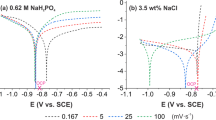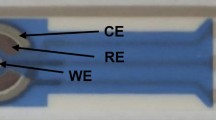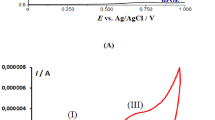Abstract
THE a.c. polarographic method of Brewer and Gutmann1, in which a.c. instead of d.c. current is measured against polarization potential, has hitherto not been extended to the determination of compounds reducible or oxidizable at potentials more positive than the potential of dissolution of mercury. This limitation is due to the difficulty of reproducing a.c. current-voltage curves obtained with solid electrodes. Changes in the nature of the surface of the electrode are responsible for poor reproducibility in conventional voltammetry2; even worse results can be expected in a.c. voltammetry because changes in the nature of the electrode modify the impedance much more than the resistance of the double layer during the electrolytic process.
This is a preview of subscription content, access via your institution
Access options
Subscribe to this journal
Receive 51 print issues and online access
$199.00 per year
only $3.90 per issue
Buy this article
- Purchase on Springer Link
- Instant access to full article PDF
Prices may be subject to local taxes which are calculated during checkout
Similar content being viewed by others
References
Brewer, B., and Grutman, F., Austral. J. Sci., 8, 21 (1945). For a general survey, Brewer, B., Gutman, F., and Baur, H. H., Oesterreich. Chem. Ztg., 57, 67 (1956).
Kolthoff, I. M., and Tanaka, N., Anal. Chem., 26, 632 (1954).
Kemula, W., and Kublick, Z., Nature, 182, 793 (1958).
Author information
Authors and Affiliations
Rights and permissions
About this article
Cite this article
JULIARD, A. Cyclic Alternating-Current Voltammetry with a Platinum Electrode. Nature 183, 1040–1041 (1959). https://doi.org/10.1038/1831040a0
Issue Date:
DOI: https://doi.org/10.1038/1831040a0
This article is cited by
-
D�termination microquantative de l'anion Hexacyanoferrique
Mikrochimica Acta (1974)
Comments
By submitting a comment you agree to abide by our Terms and Community Guidelines. If you find something abusive or that does not comply with our terms or guidelines please flag it as inappropriate.



